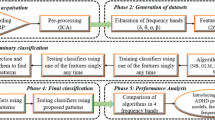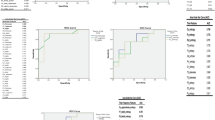Abstract
Early diagnosis of attention deficit and hyperactivity disorder (ADHD) by experts is difficult. Some solutions using electroencephalography (EEG) signals have been presented in the literature to solve this problem. However, few studies have aimed to determine which recording statuses and which channels are effective for the diagnosis of ADHD. In this study, the effects of photic stimuli at different frequencies and on different channels on ADHD diagnosis were analysed. The main purpose of this study is to reveal the most effective channel and the most effective recording status for ADHD diagnosis. In this way, EEG data can be obtained from effective channels and recording statuses, and ADHD classification can be performed with fewer channels and higher accuracy. This can reduce the amount of data to be processed and the numbers of recording procedures. The dataset used in the experiments of this study was obtained using power spectral densities and spectral entropy values. These values were obtained from individuals with and without ADHD. When these data were applied to long short-term memory (LSTM), support vector machine (SVM), and artificial neural network classifiers, the highest accuracy was obtained with LSTM. The accuracy of LSTM was calculated as 88.88% on the “Fp1,F7” channel and 92.15% in the eyes-closed resting state. Spectral entropy was found to contribute positively to the accuracy. As a result, the potential difference between “Fp1,F7” electrodes in the eyes-closed resting state proved to be effective in diagnosing ADHD.












Similar content being viewed by others
References
Barkley RA, Guevremont DC, Anastopoulos AD, Fletcher KE (1992) A comparison of three family therapy programs for treating family conflicts in adolescents with attention-deficit hyperactivity disorder. J Consult Clin Psychol 60(3):450–462
Willcutt EG (2012) The prevalence of DSM-IV ADHD: a meta-analytic review. Neurotherapeutics 9(3):490
Nazhvani AD, Boostani R, Afrasiabi S, Sadatnezhad K (2013) Classification of ADHD and BMD patients using visual evoked potential. Clin Neurol Neurosurg 115(11):2329–2335
Nunes LC, Pinheiro PR, Pequeno TC (2009) An expert system applied to the diagnosis of psychological disorders. In: 2009 IEEE International Conference on Intelligent Computing and Intelligent Systems, pp 363–367
Zhang X, Hu B, Ma X, Moore P, Chen J (2014) Ontology driven decision support for the diagnosis of mild cognitive impairment. Comput Methods Programs Biomed 113(3):781–791
Jasper HH, Solomon P, Bradley C (1938) Electroencephalographic analyses of behavior problem children. Am J Psychiatry 95(3):641–658
Bandettini PA (2012) Twenty years of functional MRI: the science and the stories. Neuroimage 62(2):575–588
Savoy RL (2001) History and future directions of human brain mapping and functional neuroimaging. Acta Physiol 107(1–3):9–42
Tcheslavski GV, Beex AA (2006) Phase synchrony and coherence analyses of EEG as tools to discriminate between children with and without attention deficit disorder. Biomed Signal Process Control 1(2):151–161
Lenartowicz A, Lu S, Rodriguez C, Lau EP, Walshaw PD, McCracken JT, Loo SK (2016) Alpha desynchronization and frontoparietal connectivity during spatial working memory encoding deficits in ADHD: A simultaneous EEGfMRI study. NeuroImage 11:210–223
Sánchez-González A, García-Zapirain B (2017) Electroencephalography Mu rhythm suppression analysis during observation-execution tasks in children with attention-deficit/hyperactivity disorder. J Med Imaging Health Inform 7(5):1005–1012
Mazaheri A, Fassbender C, Coffey-Corina S, Hartanto TA, Schweitzer JB, Mangun GR (2014) Differential oscillatory electroencephalogram between attention-deficit/ hyperactivity disorder subtypes and typically developing adolescents. Biol Psychiatry 76(5):422–429
Clarke AR, Barry RJ, McCarthy R, Selikowitz M (2001) Age and sex effects in the EEG: differences in two subtypes of attention-deficit/hyperactivity disorder. Clin Neurophysiol 112(5):815
Blandon DZ, Munoz JE, Lopez DS, Gallo OH (2016) Influence of a BCI neurofeedback videogame in children with ADHD. Quantifying the brain activity through an EEG signal processing dedicated toolbox. In: 2016 IEEE 11th Colombian Computing Conference, CCC 2016—Conference Proceedings, pp 1–8
Sadatnezhad K, Boostani R, Ghanizadeh A (2011) Classification of BMD and ADHD patients using their EEG signals. Expert Syst Appl 38(3):1956–1963
Lee SH, Abibullaev B, Kang WS, Shin Y, An J (2010) Analysis of attention deficit hyperactivity disorder in EEG using wavelet transform and self organizing maps. In: ICCAS 2010—International Conference on Control, Automation and Systems, pp 2439–2442
Chen H, Chen W, Song Y, Sun L, Li X (2019) EEG characteristics of children with attention-deficit/hyperactivity disorder. Neuroscience 406:444–456
Kaur S, Arun P, Singh S, Kaur D (2019) EEG Based Decision Support System to Diagnose Adults with ADHD. In: 2018 IEEE Applied Signal Processing Conference, pp 87–91
Khoshnoud S, Shamsi M, Nazari MA (2016) Non-linear EEG analysis in children with attention-deficit/ hyperactivity disorder during the rest condition. In: 2015 22nd Iranian Conference on Biomedical Engineering, ICBME, pp 87–92
Chen H, Song Y, Li X (2019) A deep learning framework for identifying children with ADHD using an EEG-based brain network. Neurocomputing 356:83–96
Shannon CE (1948) A mathematical theory of communication. Bell Syst Tech J 27(3):379–423
Fell J, Röschke J, Mann K, Schäffner C (1996) Discrimination of sleep stages: a comparison between spectral and nonlinear EEG measures. Electroencephalogr Clin Neurophysiol 98(5):401–410
Kannathal N, Choo ML, Acharya UR, Sadasivan PK (2005) Entropies for detection of epilepsy in EEG. Comput Methods Prog Biomed 80(3):187–194
Welch PD (2000) The use of fast fourier transform for the estimation of power spectra: a method based on time averaging over short, modified periodograms. IEEE Trans Audio Electroacoust 15(2):70–73
Aydemir Ö (2016) Common spatial pattern-based feature extraction from the best time segment of BCI data. Turkish J Electr Eng Comput Sci 24(5):3976–3986
Cortes C, Vapnik V (1995) Support-vector networks. Mach Learn 20(3):273–297
Whittington JCR, Bogacz R (2019) Theories of error back-propagation in the brain. Trends Cogn Sci 23(3):235–250
Cruz A, Ampatzidis Y, Pierro R, Materazzi A, Panattoni A, De Bellis L, Luvisi A (2019) Detection of grapevine yellows symptoms in Vitis vinifera L. with artificial intelligence. Comput Electron Agric 157:63–76
Jung S (2019) Semantic vector learning for natural language understanding. Comput Speech Lang 56:130–145
Michielli N, Acharya UR, Molinari F (2019) Cascaded LSTM recurrent neural network for automated sleep stage classification using single-channel EEG signals. Comput Biol Med 106:71–81
Liu F, Chen Z, Wang J (2019) Video image target monitoring based on RNN-LSTM. Multimed Tools Appl 78(4):4527–4544
Mahata SK, Das D, Bandyopadhyay S (2019) Mtil 2017: machine translation using recurrent neural network on statistical machine translation. J Intell Syst 28(3):447–453
Hopfield JJ (1982) Neural networks and physical systems with emergent collective computational abilities. Proc Natl Acad Sci USA 79(8):2554–2558
Jordan MI (1997) Serial order: a parallel distributed processing approach. Adv Psychol 121:471–495
Schmidhuber J, Hochreiter S (1997) Long short-term memory. Neural Comput 9(8):1735–1780
Sak H, Senior A, Beaufays F (2014) Long short-term memory recurrent neural network architectures for large scale acoustic modeling. In: Fifteenth annual conference of the international speech communication association
Tosun M (2020) Novel eye blink artefact detection algorithm from raw EEG signals using FCN based semantic segmentation method. IET Signal Process. https://doi.org/10.1049/iet-spr.2019.0602
Abualigah L, Diabat A, Mirjalili S, Abd Elaziz M, Gandomi AH (2021) The arithmetic optimization algorithm. Comput Methods Appl Mech Eng 376:113609
Abualigah L, Diabat A (2020) A comprehensive survey of the Grasshopper optimization algorithm: results, variants, and applications. Neural Comput Appl 1–24
Abualigah L, Diabat A (2021) Advances in Sine Cosine Algorithm: a comprehensive survey. Artif Intell Rev 1–42
Author information
Authors and Affiliations
Corresponding author
Ethics declarations
Ethical approval
This study was approved by the university human research ethics committee with this number of 2015-KAEK-86/15. All procedures performed in studies involving human participants anonymously were in accordance with the ethical standards of the institutional research committee and with the Helsinki Declaration as revised in 2013.
Additional information
Publisher's Note
Springer Nature remains neutral with regard to jurisdictional claims in published maps and institutional affiliations.
Rights and permissions
About this article
Cite this article
Tosun, M. Effects of spectral features of EEG signals recorded with different channels and recording statuses on ADHD classification with deep learning. Phys Eng Sci Med 44, 693–702 (2021). https://doi.org/10.1007/s13246-021-01018-x
Received:
Accepted:
Published:
Issue Date:
DOI: https://doi.org/10.1007/s13246-021-01018-x




